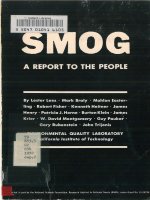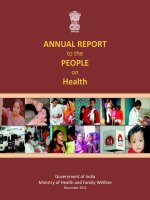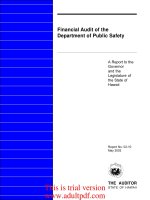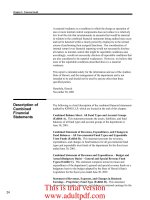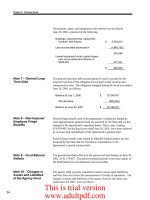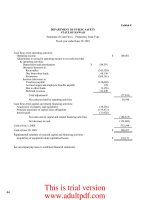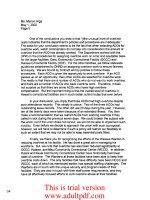Smog - A REPORT TO THE PEOPLE Episode 6 docx
Bạn đang xem bản rút gọn của tài liệu. Xem và tải ngay bản đầy đủ của tài liệu tại đây (687.44 KB, 17 trang )
sources by requiring reductions m the stack concentrations, as shown in
Table 13.
Several techniques have been used to achieve these reductions without
affecting the boiler efficiency. One is multiple-stage combustion, which
achieves some reduction in the peak temperatures of the combustion flame.
This reduction can be further augmented by flue-gas recirculation, but recirculation is more difficult to retrofit to existing boilers. Another technique
involves reducing the excess air, so that combustion is closer to stoichiometric, while carefully avoiding any increase in hydrocarbon or carbon
monoxide emissions.
Similar techniques could be applied to many other industrial boilers and
heaters in use. The petroleum industry is the largest contributor. Most likely
additional rules will be required so that Rule 68-type constraints are applied
to these NO x producers.
Industrial plants also use large internal combustion engines (operating
with process-produced fuel gas) to supply mechanical power for pumping,
etc. These engines would respond to the same NO x control techniques
used for automobiles, such as exhaust gas recirculation, manifold or catalytic
exhaust reactors, etc., to reduce their NO x emissions. However, additional
rules would be needed, since these sources are not controlled by any of the
present regulations.
A feasible control program is outlined in quantitative terms in Table 14.
The strategy involves achieving some reductions from each of several source
types by one of the possible control techniques. Additional reductions of
about 14 tons per day are possible in large boilers and small power plants by
utilizing flue-gas recirculation, as well as low excess air, at an additional
cost of about 14 million dollars.
One problem facing the NO x reduction program is the difficulty in
obtaining sufficient natural gas to meet the fuel requirements over the next
few years. This shortage will necessitate burning oil, with resultant higher
NO x levels because of poorer combustion control.
TABLE 10
Sources of Reactive Hydrocarbons (tons/day)
Industrial
Chemical
15
Petroleum
60
(Solvents)
(Solvents)
(Solvents)
55 }
10
15
--
TOTAL
Other
Commercial
Residential
{ Station Filling
Auto Filling
Other
17
31
12
Total Solvents
80
155
Source: Los Angeles County Air Pollution ControL District, Profile, 1971.
87
TABLE 11
Reactive HC Reduction (L.A. County)
Gasoline Station Tank
Filling
SOURCE
II
III
IV
CONTROL MEASURE
Vapor recovery
system
Gasoline Station Auto
Filling
Vapor recovery
system
Solvent Degreasing
NUMBER
OF SOURCES
CURRENT
EMISSIONS
TONS/DAY
34,000
11,300
Dry Cleaning
00
00
TOTAL
More complete vapor
recovery system
25
COST:
M JLLlONS
OF UOLLARS
20
100
20
10
40
100
40
30
26
Switch to zero
reactivity solvent
REDUCTION
EMISSIONS
REDUCTION
TONS/DAY
100
26
zero cost
5
100
5
1
91
41
91
%
Source: Trijonis, John, "An Economic Air Pollution Model. Application: Photochemical Smog in Los Angeles County in 1975," Summer, 1972.
Another problem that requires careful attention is the increasing use of
gas turbines by electric utilities in this Basin for peaking power. Because of
their relatively small size, these units meet the standards set by Rule 67,
even though they produce much higher NO x emissions per unit of electrical
energy generated than well-designed steam plants of much larger capacity. A
consistent program for reducing NO x emissions in this Basin may require
that no new gas turbine installations be permitted after a certain date.
TABLE 12
Sources of Oxides of Nitrogen (1971)
NO x (TONS/DAY)
Industrial
Chemical
Metallurgical
Mineral
Petroleum
Power Plants
Commercial
Residential
10
15
10
95
100
l
130
25
25
280
TOTAL
Source: Los Angeles County Air Pollution Control District, Profile, 1971.
TABLE 13
Rule 68 -limitations on NOx Concentrations from
Power Plants
GAS
OIL
225 ppm
125 ppm
By December 31, 1971
By. December 31, 1974
325 ppm
225 ppm
Source: Los Angeles Air Pollution Control District, Rules and Regulations, June 7, 1971.
89
TABLE 14
Stationary Source NO x Reduction Program for L.A. County
%
REDUCTION
120
CURRENT
EMISSIONS
TONS/DAY
24
NUMBER
OF SOURCES
EMISSION
COST:
REDUCTION
MILLIONS
TONS/DAY
F DOLLARS
10
2.4-
SOURCE
Large industrial boilers
('>30 MBTU/hr)
CONTROL MEASURE
Low excess air
II
Large refinery heaters
(>90 MBTU/hr)
Low excess air
60
14
40
6
1.8
III
Small Refinery heaters
Low excess air
160
10
40
4
3.2
IV
Large power plants
(>175MW) not
meeting Rule 68
Combustion control &
flue gas recirculation
8
76
40
30
12.0
V
Small power plants
Low excess air
37
23
30
6
3.7
Large stationary ICE's
Exhaust recirculation
140
25
75
18
0.28
Small compressor
ICE'sl
Exhaust recirculation
360
7
75
5
0.22
885
179
48
81
1
~
0
VI
VII
TOTAL
40
ICE' = Internal Combustion Engine
Source: Trijonis, John, "An Economic Air Pollution Model. Application: Photochemical Smog in Los Angeles County in 1975," Summer, 1972.
23.6
91
92
PART II: SECTION 11/5
In the long discussion of possible solutions to air pollution there has been a
"black box syndrome." There is a tendency to assume that the answer must be
some add-on device for cars and factories that would work as magically as the
television enzymes chewing up wash-day dirt. The EQL team looked for but
found no magic boxes. They assumed none existed, at least for the next few
years when we will be striving to meet the new federal air quality standards.
The technical measures proposed by the EQL team represented technology
they felt was actually available and practical between now and 1977. Clearly
it is not enough, particularly for the control of automotive emissions.
This is the reason why socio-economic measures designed to cut emissions
by reducing the use of motor vehicles were added to the proposals. Their
feasibility is much more difficult to argue than that for the technical measures.
But if one assumes that an all-out effort should be made to meet the air quality
goals and deadlines of the Clean Air Amendments, then it is clear that various steps must be taken to control vehicle use. The EQL team settled for a
modest 20% reduction in the number of vehicle miles driven within the Basin,
realizing that public acceptance of such a different approach will be problematical.
The central proposal in this area is a system of taxing emission from motor
vehicles. The taxes, if high enough, would promote a whole range of alternatives that would reduce automotive emissions. One alternative would be to
drive less and use other forms of transportation more. Others would involve
shifting to less-polluting vehicles, for example, newer ones or others using
gaseous fuels.
Necessarily, emissions taxes depend on mandatory inspection and testing
of motor vehicles, a system that would also insure that all technical measures
for reducing emissions from both new and used cars were working at maximum
efficiency-or at all.
Other socio-economic measures are proposed to reinforce the results of taxing emissions. A scheme for subsidizing the export of older, high-emission
cars from the Basin is put forward. A system of incentives and penalties to
more directly promote the kinds of transportation alternatives people would
need in order to reduce their emissions taxes is outlined. Essentially, it proposes the freeways as immediately available "tracks" for a mass, rapid transit
system. Buses and car pools would be given the advantage over driver-only
cars with reserved freeway lanes or priority access to freeways, and the effect
of these measures would be reinforced by cheap parking for car pools, expensive parking for driver-only cars, and expanded and cheaper bus service. A
scheme for rationing gasoline is proposed "as a last resort."
93
11/5
SOCIAL AND ECONOMIC INCENTIVES AND
DISINCENTIVES DESIGNED TO REDUCE EMISSIONS
11/5.1 Introduction
Part I of this report and Sections 3 and 4 of Part II propose a series of new
"technical" controls on stationary sources of emissions and on used motor
vehicles. But even in the short run (1972-1977) these technical measures
alone are not sufficient to achieve the management air quality standards set
down in Part I, page 9, and Part III, Section 1.3. We found it necessary to
down in Sections 1/2.1 and 11/1.3. We found it necessary to combine the technical measures with a set of social and economic incentives and disincentives
designed to encourage a shift to low-pollution motor vehicles, to encourage
the use of multiple-occupancy vehicles (buses, carpools, etc.), and to reduce
the annual rate of increase in gasoline consumption in the Basin.
There are three main reasons for turning to these social and economic
measures: (1) the rapidly increasing incremental cost of cutting emissions by
means of technical controls alone once the total emissions in the Basin are
reduced to about 50% of their 1970 levels;l (2) the annual rate of increase in
total emissions in the Basin attributable to growth that would eventually
overwhelm even the best control technology likely to be available in this
decade (Figure 14); (3) the advantages, in terms of efficiency, of economic
incentive systems in comparison to purely technical-regulatory approaches.
The measures we propose in this section will work in the short run to speed
up the process of achieving improved air quality and to introduce some flexibility into our proposed strategy. In the longer run these socioeconomic
measures will continue to provide incentives to reduce emissions even after
all automobiles on the road meet the 1975/76 Federal standards. It will be
argued in Section 11/6 that fundamental changes in life-styles and technologies are needed to provide a long-term solution to the problem of controlling
air pollution in this Basin. Although the measures discussed in this section
have more immediate impact, they would help prepare the way for larger
social change.
In Section 11/5.2 we discuss the basic concept of "internalization of risk"
and the need to stimulate the development of a widely varied and flexible
menu of alternatives to clean up the environment. One way to put a policy
of risk-internalization into operation is by means of an emissions tax based
on the total amount of "harmful" emissions emitted by an automobile
(Section 11/5.3). This control measure, designed to induce motorists to
pollute less, could be made more efficient by a system of incentives to promote the export of old high-emission cars out of the Basin (Section 11/5.4).
The provision of economically and socially viable alternatives to the
payment of the emissions tax is clearly an important part of the strategy.
'Trijonis, John, An Economic Air Pollution Model Application: Photochemical Smog in Los
Angeles County in 1975, Summer, 1972. Copies available from the EQL on request.
94
In Section II/5.5 we propose a system of mutually reinforcing incentives and
disincentives that promote the use of multiple-occupancy vehicles such as
buses, carpools and jitney cabs, and that penalize driver-only cars.
Finally, in Section II/5.6 we discuss two possible gasoline rationing
schemes that would reduce the annual rate of increase in gasoline
consumption.
The measures discussed in this section represent relatively new approaches
to the problem of controlling motor vehicle emissions. Each measure needs
further study and discussion. Ways in which these measures might best be
combined among themselves and with subsidies and regulatory programs
need to be investigated. These measures, then, are not exclusive responses,
nor are they "final." Research on this aspect of air pollution control is continuing at the EQL. The main purpose here is to introduce some ideas,
analyze their advantages and disadvantages, and stimulate badly needed
discussion among the public and the policy-makers.
11/5.2 The Public Policy Issues
What is the appropriate concept to use in order to design an effective strategy
to deal with the problems of the environment? According to conventional
wisdom, the appropriate rationale is internalization of the costs of environmental degradation. Firms and individuals would be required to spend
such amounts to improve environmental quality as will make the marginal
benefits equal to the marginal costs. However, it will be argued here that
despite its intrinsic logic, internalization of costs doesn't provide an operational concept adequate to deal with the problems of the environment. What,
then, is the appropriate concept? Whil~ there isn't any ideal concept, a better
approximation to reality is "internalization of risk."
The concept of cost internalization relies on cost-benefit analysis, but
there are two serious problems with cost-benefit analysis. One of them is that
even if the costs and benefits could be precisely measured, there isn't any
obvious way to take into account the fact that each person will be affected
differently, both as he perceives the benefits and is affected by cost internalization. Hence, there is no unarbitrary way to relate individual costs to social
costs and individual benefits to social benefits. How, in fact, these calculations get made depends in large part on the nature of the political process.
A second and even more serious limitation of cost-benefit analysis is the
absence of theories that would enable us to predict the potential benefits
in economic terms. There is no way to provide a damage function for human
receptors, because the consequences to present and future generations of
people can be foreseen only as incalculable risks (e.g., the risk that smog
will result in a substantial increase in the incidence of respiratory diseases).
And whether policy makers act now or wait to impose air qualit~ manaBement standards unta more is known about the risk, they are, in either event,
engaged in very arbitrary judgments.
95
Thus, the problems facing the country in dealing with degradation of the
environment aren't those of "static efficiency," that is, of choosing among
existing alternatives and balancing predictable costs against predictable
benefits. They are, rather, "dynamic efficiency" problems, which means
they are problems of making decisions in the face of strong uncertainties
(uncertainties which cannot be reduced to a known probabilistic basis) and
of resolving a host of conflicts between theory and practice. The aim is to
produce a better menu of alternatives, thus reducing the risks to society
as a whole.
There is no correct method of deciding beforehand how much society
should spend on the prevention of environmental degradation. That will
become clearer only when more is known about the risks, for example, when
as much is known as, say, is now known about the effects of smoking on lung
cancer. It should be apparent, however, that just as there are risks of doing
too much, so are there risks of doing too little.
Risks for society as a whole are not necessarily risks for the individual
business firm or person. The immediate policy question is how risks for society
as a whole can be translated into risks for the business firm and the individual, that is, how such risks can be internalized.
A. The Appropriate Concept: Internalization of Risks
The argument for risk internalization doesn't rest simply on its theoretical
appeal. The fact of the matter is, it isn't only an interesting theory: it works.
For one thing, it has played a major role in the economic development of
this country. Econometric analysis has revealed that during the period
1919-1957 only about one-eighth of the increase of the gross national product per worker can be explained by the increase in capital per workerleaving seven-eighths to be explained as a mysterious new form of energy
called "technological change." There is good reason for believing that technological competition played a very important role in producing this "new"
form of energy. Furthermore, it can b<; stated that technological competition
played a major role in making this country the undisputed technological
leader of the world from, roughly, the beginning until the middle of this
century. Starting in agriculture, shortly after the Civil War, the concept of
technological competition soon spread to industry. There are substantial
reasons for believing that, in part, the U.S. enjoyed a comparative advantage
in trading with the rest of the world because of the role technological competition played and, in part, because of broader sociological factors which favored a highly pragmatic society adept at dealing with conflicts between
theory and practice.
Of course, no one could have predicted in, say, 1900 just what would be
the outcome of all the competition, flexibility and pragmatism which characterized this country.
However, the test of good economic theory doesn't consist of being able
to predict the unpredictable, but rather of trying to understand the conditions
96
which produce certain kinds of beneficial mutations, and how to translate
risks for society as a whole into market risks for the individual firm or person.
B. Implementing A Policy of Risk-Internalization: Some
of the Key Issues
How might a policy of risk-internalization be put into operation? One way, to
be discussed in detail in the next section, is through an emissions tax. Here
the idea is only briefly described to show how it is related to the concept of
risk-internalization and what general kinds of policy issues arise from implementing such a concept.
Assume that an automobile emissions tax is levied in conjunction with an
inspection scheme. Assume, further, that the difference between owning a low
emitting car and a high emitting car is a difference of, say, $300 a year. The
immediate impact of such a tax would be on the consumer: Presumably, he
would drive less or discover in some cases that a second car was unnecessary
(i.e., several studies have indicated that carpooling becomes a very attractive
option at about $300 per year), and! or shift to a lower polluting type of car.
How might such a tax bring about an internalization of risk-taking? For one
thing automobile dealers would be more conscious of the risks to society as a
whole of pollution devices which weren't easy to maintain. People would
scream if they had to pay high taxes because a "clean-on-delivery" car turned
out to be very difficult to maintain. And their screaming might force automobile dealers to offer a 20,000 mile warranty on the air pollution devices.
In addition, an emissions tax would provide a way to introduce into the
automobile industry a concept of dynamic workable competition in which
automobile emissions became a major factor in determining a manufacturer's share of the market. Thus, the effect of adding an emissions tax up to,
say, $300 a year would be like adding an excise tax of $300 a year; and the
effect of producing a car which didn't have to pay any emissions tax would be
like being exempt from such a tax. Whether dealers were forced to absorb
such a tax or whether it resulted in a direct loss of sales, it certainly would
provide manufacturers with strong incentives to push as hard as they could
for continued improvements in emissions control technology. The risks
associated with being technologically backward in the anti-pollution field
wouldn't be small and they would be measurable in dollars.
The more general policy issues which this example raises are the following:
(1) the respective roles to be played by incentive schemes and direct regulation; (2) how to take care of "hardship" cases in getting users to adopt the
best set of available technologies; and (3) how to insure that industry will,
in fact, compete.
1. The Relationship Between Incentive Schemes and
Direct Regulation
On~
of the
})rincipal virtues of the present method of regulation is that the
requirements placed upon industry are in terms of performance specifica97
tions rather than technical specifications. The government tells industry
what reductions in emissions must be achieved by particular dates, but it
doesn't say how industry ought to go about achieving these reductions. Regu-
lation in term5 of performance ruther than technical 5pecification5 is the
appropriate method, because technical specifications impose additional constraints on the developer-and thereby make development much more
expensive.
On the other hand the central defect of present regulatory procedures is
the assumption that regulators can, in fact, produce high-confidence estimates of achievable goals - when, in fact, they can't. The inability of the
regulatory agencies to unearth that which can be discovered only in the
process of research and development puts them in double jeopardy. Either
they are criticized for being too easy on industry or they promulgate rigid
standards which simply cannot be met-and thereby risk defeat of their own
purpose.
In order to avoid this kind of dilemma the role of regulation should be to
provide minimum targets, which if unmet by, say, auto manufacturers would
mean that they simply wouldn't be permitted to sell automobiles in high
pollution areas. And those manufacturers who do better should be correspondingly rewarded. In other words, the incentives should be continuous.
Moreover, as better alternatives are discovered, the minimum target should
be progressively tightened.
2. Hardship Cases
A main concern which frequently is voiced has to do with promoting the
adoption of already developed technology: gaseous-fueled vehicles for fleet
use and evaporative control devices for older cars are cases in point. The
simplest way to handle "hardship cases" would be not to recognize any; for
example, as in the case of Britain to make propane (or its equivalent) mandatory for all taxi cabs in London. Just as with the income tax the general
argument against providing loopholes is that there is no natural stopping
place. On the other hand, it also must be recognized that politicians sometimes aren't willing to be as harsh as they might, because they regard the
political risks as too great. Hence, all that really can be said is, to the extent
subsidies or exemptions are used, the legislation should contain a selfterminating feature which would make the subsidy or exemption expire
when it had achieved its intended purpose.
There is, however, one point which is much less controversial: That
subsidies (if permitted) ought to be created on the basis of meeting certain
performance specifications rather than in terms of adopting particular
technical devices. Thus, fleet owners should be given the same treatment
whether they use gaseous-fueled vehicles or find some other equally satisfactory way to reduce emissions. Similarly, a private owner should receive
the same subsidy whether he installs a new $150 evaporative control device
on his automobile, manages to find an equally effective device for $50, or
98
decides to scrap his second car and join a carpool. The purpose of providing
equal treatment for equally effective remedies is simply to increase the odds
that if people don't like one way of becoming a friend of the environment,
they can find another. Moreover, equal treatment clauses also provide a
way of increasing the menu of alternatives. For example, given the proper
inducements, manufacturers of electric golf carts might be persuaded to
penetrate the highway transportation market.
3. Making Dynamic Competition Work
The concept of dynamic competition supplies a highly relevant means for
internalization of risk. But will it work? The honest answer is that no one
knows. As in sports the teams sometimes compete vigorously. But again
they don't. And should dynamic competition prove to be unworkable, it will
become necessary for the government to face up to some basic issues in the
antitrust field. Moreover, especially insofar as projects involving a high
degree of risk are concerned, it may in any event become necessary for the
government to initiate a much larger publicly supported R&D effort. It is
true, of course, that policy makers are often disinclined to face up to such
basic issues: The almost inevitable response to a crisis is a series of "patchups" accompanied by the proclamation that prosperity is just around the
corner.
On the other hand what are the alternatives to increasing the performance
of business concerns via a policy of risk internalization? The only real one is
an increasing degree of government regulation and control. But there is
good reason to suspect this is not a viable alternative: In the first place, to
date at least, not one of the government's regulatory efforts can be said to
have been highly successful. In the second place, given the highly dynamic
character of environmental problems, there is good reason to doubt that
regulation alone will be even as successful in the pollution control field as it
has been with other problems in the past. If it has not been possible for the
government to keep up with the problems of the railroads, how about the
environment?
11/5.3
11/5.3.1
The Motor Vehicle Emissions Tax as an Air
Pollution Control Measure
General Considerations
An emissions tax based on "harmful" automotive emissions can be thought
of as a payment by a motorist for the privilege of driving an automobile
which contributes to the pollution problem. There are many ways of defining
and collecting such a tax, and they vary in their impact on the many decisions
made by the motorist. We will consider explicitly five types of decisions:
(1) the choice of the age and model of car owned; (2) the decision on how
99
much the car will be used; (3) the amount of maintenance to be performed on
the car; (4) the type of fuel used in the car; (5) the number of occupants in
the car.
The emi~~ions tax is not the only method available for innuencinR these
decisions, and we will discuss several very different methods in Section II/5.5.
All share a common characteristic: they impose a penalty on those motorists
who insist on owning a type of car, or using it in a manner which makes an
excessive contribution to air pollution. The emissions tax imposes a financial
penalty. Other measures, such as the introduction of restricted access to
freeways (Section III5.5) impose a penalty in terms of time spent in commuting. We will not be able to choose the proper "mix" of these methods until we
have determined which penalty gives more leverage on important decisions.
The use of a tax to affect automobile purchase and use decisions is based
on the assumption that motorists do give some consideration to the cost of
automobile travel. The extent to which this assumption is justified is a matter
of considerable debate; therefore, we must be careful to institute a tax
scheme in a manner which makes its cost visible and easy for the motorist
to determine. A concealed tax is worse than useless: It imposes a financial
burden, which may be substantial, without inducing the environmentally
appropriate behavior which we desire.
11/5.3.2
The Types of Emissions Tax
There are three basic rationales which have been used to recommend the
institution of an emissions tax. Depending on the rationale chosen, the tax
will be set at varying levels, and the type and amount of information needed
to determine the charge will differ. We label the types of scheme which result
from these rationales the emissions charge, the emissions tax and the emissions fee.
A. The Emissions Charge
Some economists propose that an emissions charge be used as the fundamental device both for choosing and for achieving desirable levels of air
pollution. The charge is set at a level which reflects the value of the incremental damage done to society by an additional unit of emissions. Then, it
is argued, each motorist will choose to reduce his contribution to pollution
until the cost of an additional unit of emissions reduction equals the charge
which he must pay for the privilege of putting out that unit.
When the charge equals the damage done by an additional unit of emissions, it follows that the cost of further reduction in emissions exceeds the
damage which would be avoided by reduction in emissions. Therefore, it is
argued, the level of air quality achieved by the emissions charge is the
"desirable" level, in the sense that it minimizes the sum of the damage done
by pollution and the costs incurred in reducing pollution.
100
The major difficulty with this concept of emissions charges is that the
damage done by air pollution has proved itself nearly impossible to measure. 2
Moreover, in talking about "damage to society" we inevitably make some
value judgment about how to compare the damage suffered by one person
with the damage suffered by another person. The criticisms levelled at costbenefit analysis apply equally to the effluent charge proposal. There is no
ethically neutral way to define the "social damages" of air pollution, and it
is not the role of social scientists to make these ethical choices. Although we
recommend the use of financial penalties to bring about improved air quality,
we recognize that the emissions charge approach is not the correct way to
determine what the penalties should be.
B. Emissions Tax
The political system decides who shall pay for and who shall benefit from its
measures as part of its day-to-day business. In designing an emissions tax
we take as given some political decision as to the desired level of air quality,
together with the benefits to society which such a choice implies.
The emissions tax is designed to achieve the predetermined standard and
to do so in a manner which minimizes the undesirable economic impact of
pollution control. By raising the cost of using an automobile which emits
excessive quantities of harmful emissions, the emissions tax leads to changes
in the amount of driving and in the characteristics of automobiles being
driven, and thus brings about an improvement in air quality. By leaving each
motorist a free choice among many options for reducing his contribution to
air pollution so that he can respond in the manner most advantageous to
himself, the emissions tax removes the danger that motorists will be forced to
pay for unnecessary or ineffective pollution control measures. In this manner
a properly designed emissions tax can minimize the economic burden of pollution control, and can be determined without reference to the concept of"damage to society."
C. Emissions Fee
The emissions charge and the emissions tax, as we have defined them, serve
two functions: to give an incentive to reduce emissions and to allocate the
necessary reduction in emissions among motorists in an "efficient" manner.
The emissions fee serves only as an incentive. To set the fee we must determine in advance a set of desirable steps to be taken to reduce automotive
pollution. The emissions fee enters the picture because we do not enforce the
law absolutely. Rather, we impose on any motorist who does not observe
the obligations of the law a fee for the privilege of continuing to use his car.
By setting the fee higher than the average cost of compliance, we give an
incentive to motorists to satisfy the previously determined standard.
~See, for example, the pessimistic conclusions reached in Ronald G. Ridker, Economic Costs
of Air Pollution, New York, 1967.
101
The emissions fee approach is attractive because it is relatively simple to
decide on an appropriate charge level. It also allows the individual motorist
some flexibility in his choice of actions, and unlike, for example, the absolute
prohibition of cars failing an emissions test, it insures that no motorist will
face a catastroph:c penalty. No one can be forced to incur a cost greater than
the fee.
Unfortunately, the emissions fee approach shares a fundamental defect
of all schemes based on standards applying to individual automobiles. It is
infeasible to state the standards in sufficient detail and with sufficient precision to cover all the ingenious ways by which a motorist could reduce his
contribution to pollution.
Writing standards in sufficient detail to include all eventualities compares
in magnitude to the task of central economic planning. In this case it is
administratively impossible and unjustified in terms of the relation between
effort and result. We should not abandon the coordinating role of emissions
taxes by falling back on rigid standards and fees.
Moreover, a system of fees designed to bring about specific, predetermined
actions can reduce the probability that responses will go in the predicted
direction. Note that although we cannot yet predict that a tax of X dollars
will produce a decrease of Y percent in emissions, we all believe that with
some tax, emissions will not increase. The tax to achieve a specific action is
capable, because of the very real unpredictability of individual choice, of
violating this law. The individual is much more familiar with his particular
circumstance than the planner: there is a significant probability that he will
find a way out of the dilemma posed by the specific incentive which involves
increased emissions. If, on the other hand, we tax emissions directly, then the
only way a person can reduce his tax bill is by reducing his emissions.
In summary, we find that the emissions tax is administratively workable,
more efficient than uniform standards and regulations, and potentially effective in achieving desirable levels of air quality. In the remainder of this
section we will develop and defend specific proposals for emissions tax
programs.
11/5.3.3
Decisions and Instruments
The motorist makes a number of decisions which affect his contribution to air
pollution. There are also a number of ways in which we could construct and
impose an emissions tax. Roughly, our approach is to choose those decision
areas which are most effective in reducing pollution, and choose the tax
scheme which concentrates incentives on those decision areas. Moreover,
the decision areas must be not only effective in reducing pollution but
responsive to economic incentives.
Let us assume for the moment that we can measure precisely the number
of grams of pollution put out by an automobile during the course of a year.
Then we can impose a yearly tax equal to O'P, where 0' is the tax rate in
dollars per gram of emissions, and P is total emissions during the year.
102
How will the motorist respond? One person may find that he can get a
tune-up and reduce his emissions by 50%. Then during the period during
which benefits of the tune-up last the motorist will save a sum equal to onehalf of this emissions tax. If the tune-up costs less than half the emissions tax,
the motorist will save money by getting a tune-up. Another motorist may
find that a tune-up is not worthwhile, but that he would prefer driving 25%
less (perhaps by joining a carpool) in order to pay 25% less tax to c~ntinuing
to drive the same amount and paying a larger tax.
A third motorist with a car he would trade in in a year anyway may find
that by buying a new car with much lower emissions he will save enough to
justify trading in his old car immediately.
The point of the emissions tax is to leave each motorist a free choice
among many options, so that he can respond in the manner most advantageous to himself.
It has already been stated that a uniform emissions tax tends to keep total
expenditure on pollution control at the lowest level consistent with the
achievement of desired air quality. To establish this point we must distinguish
between expenditures made to pay the tax and expenditures made on reducing emissions (in which we include the monetary valuation which the
motorist puts on things he gives up). If each motorist chooses that combination of emission reduction (through tune-ups, trade-ins, reduced driving,
etc.) and tax payment which is most advantageous to him privately, then by
setting a high enough tax we can make polluting sufficiently expensive that
aggregate emissions are reduced to some desired level. This tax will also
result in each motorist choosing such abatement techniques that total expenditures made on emissions reduction are as small as possible while still
achieving desired results.
The revenues generated by the emissions tax represent an additional cost
to the motorist, but not to society, since they are pure transfers. If these
taxes simply go into the general fund and replace, for example, property
taxes, the net financial burden of the emissions tax strategy will be just the
expenditures made directly on reducing emissions. Since the property tax
causes a loss by distorting the allocation of goods (and the emissions tax does
not), the real economic cost of the strategy will be less than the cost of
reducing emissions. If the taxes are used to finance the introduction of other
measures recommended in this report, they again disappear, since they
simply represent a source of money for programs which must be funded in
some way. Because of its beneficial (rather than detrimental) allocation
effects, the emissions tax is a good source of such funds.
A theoretically perfect emissions tax would be one in which each automobile
had a device on its tailpipe (and fuel system and crankcase) which continuously analyzed the composition of waste gases and recorded the mass of
emissions. With 7.2 million cars in the Basin this degree of precision is too
expensive to be warranted. Some surrogates closely, and hopefully invariantly,
related to total mass emissions must be chosen and used to levy taxes.
103
